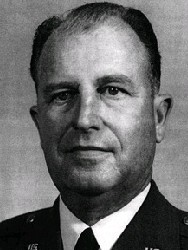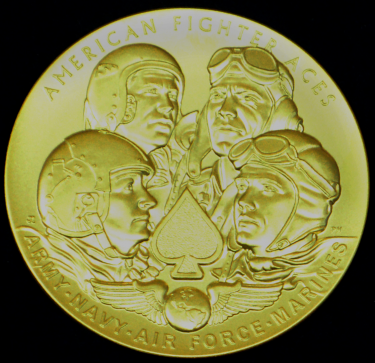
 |
|
|
||
|
Glenn Emile Duncan |
||||
|
Engagements: • World War II (1941 - 1945)• Korean War (1950 - 1953) |
||||
| Biography: | ||||
|
Glenn Emile Duncan Glenn Emile Duncan entered the U.S. Army Air Corps' Aviation Cadet Program on 1 February 1940. He was commissioned as a Second Lieutenant with the rating of pilot wings on 5 October 1940. In March 1943 Major Glenn Emile Duncan joined the 353rd Fighter Group, Eighth Air Force, U.S. Army Air Forces, in the European Theater of Operations, as Group Executive Officer. He achieved 19 aerial victories before being promoted to Lieutenant Colonel and becoming Group Commander in November 1943. Duncan named his first P-47 'Winged Death' but was ordered to change it by the higher brass, so he sarcastically renamed it 'Dove of Peace.' He had a series of planes carrying the name with the last being his P-51D-25-NA Mustang (S/N 44-73060) 'Dove of Peace VIII.' On 27 September 1943, MAJ Duncan was flying a P-47 Thunderbolt while leading a Fighter Group escort for B-17 Flying Fortresses on a bombing mission over Germany. This was one of the longest and most hazardous bomber escort missions yet flown in this Theater. The highly effective protection furnished to the escorted bombers by his Group was directly attributable to the skill in combat and leadership displayed by MAJ Duncan. Though outnumbered by the German planes attacking the formation, the superior combat tactics MAJ Duncan used for his unit accounted for the destruction of 6 enemy fighters and severe damage to others, without any loss to the Group. MAJ Duncan's courageous actions that day earned him the U.S. Army's third highest award for valor, the Silver Star Medal. On 11 November 1943, MAJ Duncan's unit was in aerial combat against German forces over enemy-occupied Europe while leading a group of fighter aircraft. As a result of leading a squadron of his group against a large number of German aircraft, MAJ Duncan became separated from his group. He saw enemy aircraft attacking bombers and, although at an unfavorable altitude and in the face of overwhelming odds, MAJ Duncan attacked the German planes, destroying one and dispersing the rest. While returning to his home base, he noticed 4 German fighters attacking a straggling B-17 Flying Fortress. Although his fuel supply was dangerously low, he engaged the enemy and dispersed them, saving the Flying Fortress and its crew. MAJ Duncan's courageous actions and extraordinary heroism that day earned him the U.S. Army's second highest award for valor, the Distinguished Service Cross. His plane was shot down during a strafing mission on 7 July 1944 but he evaded capture. He then worked with the Dutch underground until he was liberated by Allied forces in April 1945. He returned to the 353rd Fighter Group and resumed command in April 1945. He remained for occupation duty until October 1945 and then returned to the U.S. By the end of World War II, LTC Duncan was credited with destroying 19.5 enemy aircraft in aerial combat, with 1 probable and 7 damaged. He also destroyed 9 aircraft on the ground during strafing attacks. Duncan remained in the military and was transferred into the newly-established U.S. Air Force in 1947. He served in various command and staff positions over the years, both in the U.S. and abroad. His final assignment before retirement was as Special Assistant to the Vice Commander of 1st Air Force at Stewart AFB, NY, from August 1969 to 1 February 1970. Medals, Awards and Badges Distinguished Service Cross Distinguished Service Cross Citation The President of the United States of America, authorized by Act of Congress, July 9, 1918, takes pleasure in presenting the Distinguished Service Cross to Lieutenant Colonel (Air Corps), [then Major] Glenn Emile Duncan (ASN: 0-398671), United States Army Air Forces, for extraordinary heroism in connection with military operations against an armed enemy while serving as Pilot of a P-47 Fighter Airplane in the 353d Fighter Group, EIGHTH Air Force, in aerial combat against enemy forces over enemy-occupied Europe while leading a group of fighter aircraft on 11 November 1943. As a result of leading a squadron of his group against a large number of enemy aircraft, Lieutenant Colonel Duncan became separated from his group. He observed enemy aircraft attacking bombers and, though at an unfavorable altitude and in the face of overwhelming odds, Lieutenant Colonel Duncan vigorously attacked the enemy aircraft, destroying one and dispersing the remainder. While proceeding to his home base, he observed four enemy aircraft attacking a straggling Fortress. Although his gas supply was dangerously low, he engaged the enemy and dispersed them, thereby saving the Fortress and its crew. The action of Lieutenant Colonel Duncan reflect the highest credit upon himself and the armed forces of the United States. General Orders: Headquarters, European Theater of Operations, U.S. Army, General Orders No. 2 (January 10, 1944) Congressional Gold Medal The Congressional Gold Medal, created by the U.S. Mint, is the highest civilian honor Congress can give on behalf of the American people. On 20 May 2015, leaders from the U.S. House of Representatives and Senate presented the Congressional Gold Medal [see photo] to the American Fighter Aces Association at the U.S. Capitol Visitor Center Emancipation Hall. More than 60,000 American fighter pilots engaged in aerial combat during World War I, World War II, the Korean War and the Vietnam War. Of those pilots, only 1,447 earned the title of fighter “Ace” by downing at least five enemy aircraft. Colonel Glenn Emile Duncan was one of them, having been credited with 19.5 aircraft shot down in aerial combat with 1 probable and 7 damaged, qualifying him as a Triple Ace. He also destroyed 9 aircraft on the ground during strafing attacks. At the time of the presentation of the Medal, only 75 of those Aces remained alive. Death and Memorialization Colonel Glenn Emile Duncan died on 14 July 1998. A cenotaph for him is located at the Arlington National Cemetery in Arlington, Arlington County, VA. https://www.findagrave.com/cgi-bin/fg.cgi?page=gr&GRid=22032647 |
||||
| Honoree ID: 312783 | Created by: MHOH | |||
Ribbons
Medals
Badges
Honoree Photos
 |  |  |
 |  |
 |


